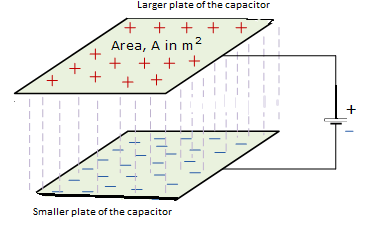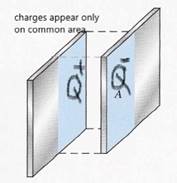A parallel-plate capacitor has plates of unequal area. The larger plate is connected to the positive terminal of the battery and the smaller plate to its negative terminal. Let Q+ and Q– be the charges appearing on the positive and negative plates respectively.
Given:
A parallel plate capacitor with plates of unequal area and charges on larger and smaller plates are Q+ and Q- respectively

Explanation:
When you have two plates of unequal areas facing each other , the electric field is present only in their common area ignoring fringe effects.)
Therefore, charges acquire only on the facing common areas of the plates of the capacitor. So, if the plates have unequal area it doesn’t matter as only the common facing area of both the plates acquire charges
Therefore, we are left with a capacitor with plates area A where A is the common area
